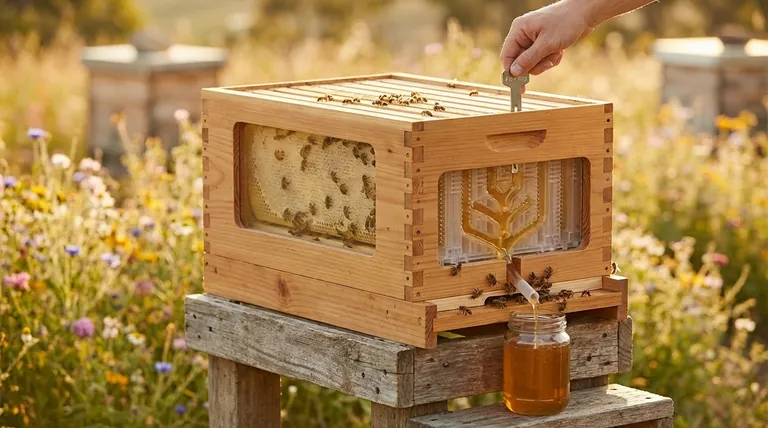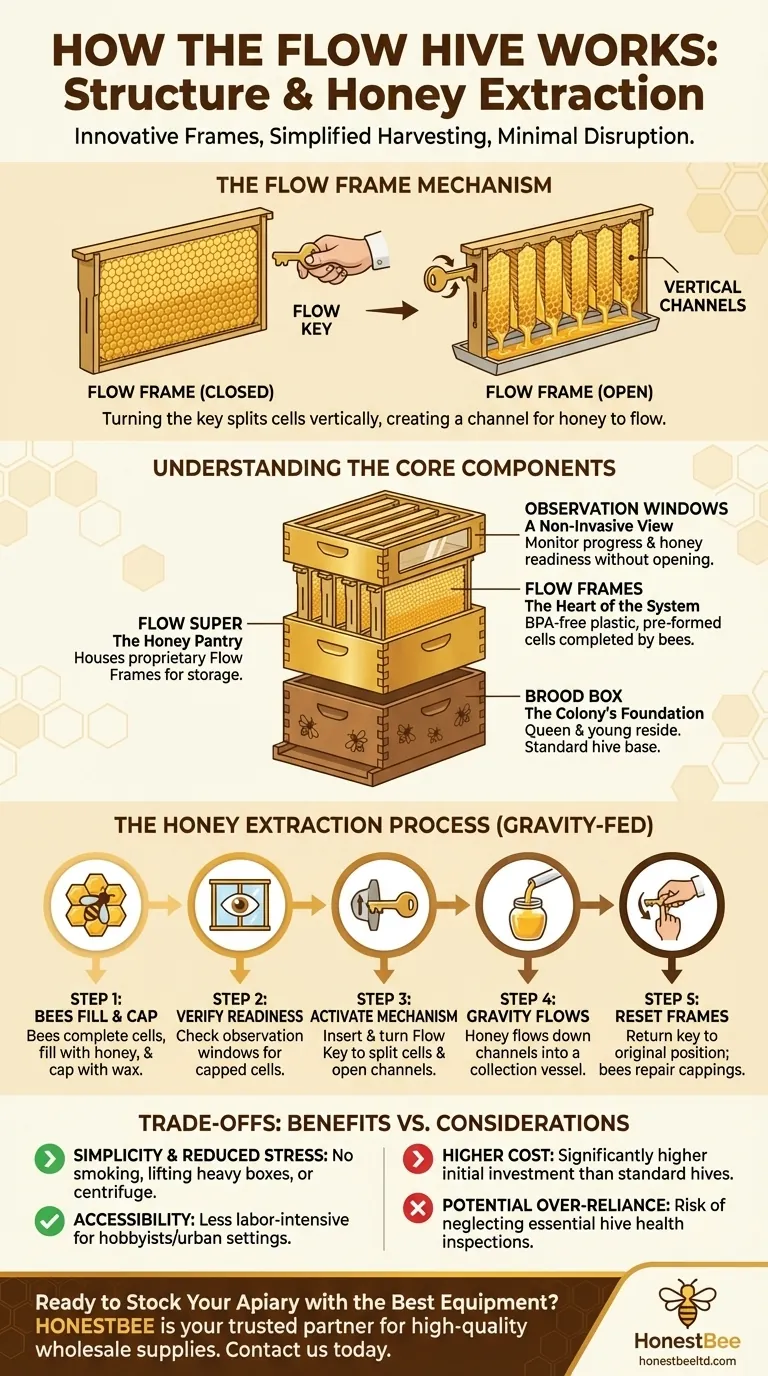At its core, the Flow Hive works by using specially designed frames that function like a tap for honey. These frames contain partially formed plastic honeycomb cells. When a beekeeper inserts and turns a key, the cells split vertically, creating channels that allow honey to flow directly out of the hive and into a collection jar, all without opening the hive or disturbing the bees.
The Flow Hive's true innovation is not just the "tap" itself, but the underlying frame technology that allows honey to be harvested with minimal stress to the colony and significantly less labor for the beekeeper. It trades traditional equipment and processes for a higher-cost, convenience-oriented system.

Understanding the Core Components
The Flow Hive's design is built upon a standard hive structure but with one revolutionary modification: the honey storage frames. Understanding this anatomy is key to grasping how the system functions.
The Brood Box: The Colony's Foundation
Like any standard beehive, the Flow Hive has a brood box at the bottom. This is the heart of the colony, where the queen bee lays her eggs and the colony raises its young. This part of the hive functions identically to a traditional one.
The Flow Super: The Honey Pantry
Stacked on top of the brood box is the "Flow Super," the box dedicated to honey storage. While it looks like a normal hive box from the outside, it is designed specifically to house the proprietary Flow Frames.
The Flow Frames: The Heart of the System
This is the central innovation. Instead of traditional wooden frames with wax foundation, Flow Frames are made from a BPA and BPS-free plastic. They feature a matrix of partially formed honeycomb cells. The bees complete these cells with their own wax before filling them with honey and capping them.
Observation Windows: A Non-Invasive View
A key feature is the inclusion of clear end-frame views and side observation windows. These allow the beekeeper to monitor the bees' progress and determine when the honey is ready for harvest without having to open the hive and disrupt the colony.
The Honey Extraction Process Explained
The Flow Hive transforms honey harvesting from a multi-step, labor-intensive process into a simple, gravity-fed operation.
Step 1: Bees Fill and Cap the Cells
The honey bees accept the plastic foundation and get to work. They complete the cell walls with their own wax, fill the cells with honey, and then cap the honey with a final wax layer once it has been dehydrated to the correct moisture content.
Step 2: The Beekeeper Verifies Readiness
Using the observation windows, the beekeeper can see when a frame is full and the cells are capped. This is the visual cue that the honey is mature and ready for harvest.
Step 3: The Key Activates the Mechanism
The beekeeper inserts a tool called a "Flow Key" into a slot at the top of the frame and turns it. This action offsets the two layers of cells inside the frame, breaking the wax cappings and creating vertical channels through the middle of the honeycomb.
Step 4: Gravity Does the Work
With the channels now open, the honey simply flows downward. It runs through a sealed trough system at the bottom of the frame and out a tube, draining directly into a jar or bucket. The bees inside remain largely undisturbed by this process.
Step 5: Resetting the Frames
Once the honey has drained, the beekeeper turns the key back to its original position. This realigns the cells. The bees then begin the process of repairing the broken cell cappings and cleaning up the residual honey, preparing the frame to be filled again.
Understanding the Trade-offs of the Flow System
While revolutionary, the Flow Hive presents a distinct set of benefits and considerations compared to traditional beekeeping methods.
The Benefit: Simplicity and Reduced Bee Stress
The primary advantage is the profound simplification of the harvest. It eliminates the need to smoke the bees, lift heavy boxes, pull out individual frames, and transport them to a separate location for extraction with a centrifuge. This is significantly less stressful for the colony.
The Benefit: Accessibility for Hobbyists
For urban beekeepers or hobbyists, the system is less messy, sticky, and labor-intensive. It removes the need for costly and bulky extraction equipment, making beekeeping more approachable for those with limited space or physical strength.
The Drawback: Cost and Material
Flow Hives have a significantly higher initial cost than a standard Langstroth hive setup. Furthermore, some beekeeping purists prefer to avoid the use of plastic components within the hive, favoring all-natural wood and wax.
The Drawback: Potential for Over-Reliance on Convenience
Because the system is so easy to use, there is a risk that new beekeepers may neglect essential hive health inspections. Beekeeping is more than just honey harvesting; it requires regularly checking for pests, disease, and the queen's health, which still requires opening the hive. The Flow Hive simplifies one task, not the entire practice.
Making the Right Choice for Your Goals
The decision to use a Flow Hive should be based on your specific priorities as a beekeeper.
- If your primary focus is convenience and minimizing disruption during harvest: The Flow Hive is an exceptionally well-designed tool that achieves this goal better than any other system.
- If your primary focus is learning traditional beekeeping from the ground up: Starting with a standard Langstroth hive will build a more comprehensive and transferable skillset before you adopt specialized convenience tools.
- If your primary focus is budget: The high initial investment for a Flow Hive is a critical factor, as traditional equipment can be acquired for a fraction of the cost.
Ultimately, the Flow Hive is a powerful tool designed to solve the specific challenge of honey extraction, and understanding its place in the broader context of beekeeping is key to using it wisely.
Summary Table:
| Component | Function |
|---|---|
| Brood Box | Standard base where the queen lives and the colony raises young. |
| Flow Super | Box housing the special frames, dedicated to honey storage. |
| Flow Frames | Plastic frames with pre-formed cells that bees fill with honey. |
| Observation Windows | Allow beekeepers to check honey readiness without opening the hive. |
| Flow Key | Tool that, when turned, splits the cells to start the honey flow. |
Ready to Stock Your Apiary with the Best Equipment?
Whether you're a commercial apiary looking for efficient solutions or a distributor seeking high-quality wholesale beekeeping supplies, HONESTBEE is your trusted partner. We supply durable, reliable equipment to help your operation thrive.
Contact us today to discuss your needs and see how we can support your success.
Visual Guide

Related Products
- HONESTBEE Advanced Ergonomic Stainless Steel Hive Tool for Beekeeping
- HONESTBEE 72 Frame Industrial Electric Honey Extractor for Beekeeping
- Professional Dual-End Stainless Steel Hive Tool for Beekeeping
- Plastic Hand Crank 2 Frame Honey Extractor Low Price
- Professional 3-Bar Frame Grip with Integrated Hive Tool
People Also Ask
- Why is it important to compare the progress of different hives? A Beekeeper's Key Diagnostic Tool
- Why do hive tools have a hole? Unlock the Secret to Efficient Beekeeping
- What is a hive tool and what are its uses? Master Your Hive Inspections with the Essential Beekeeper's Tool
- What tools are used for cleaning frames? A Beekeeper's Simple 4-Tool Guide
- What are the features of a regular hive tool? The Essential Multi-Tool for Every Beekeeper



















